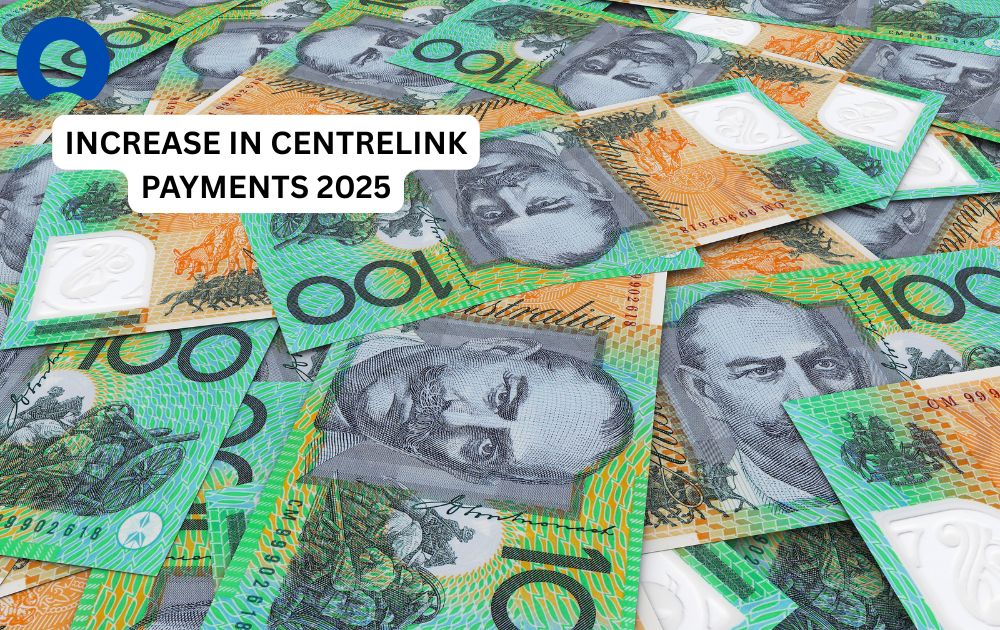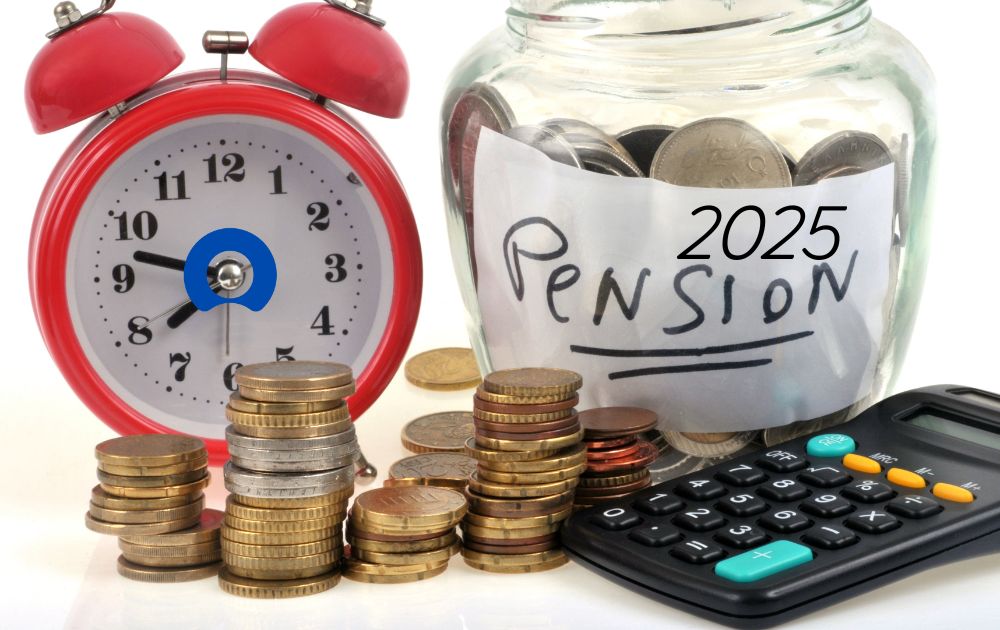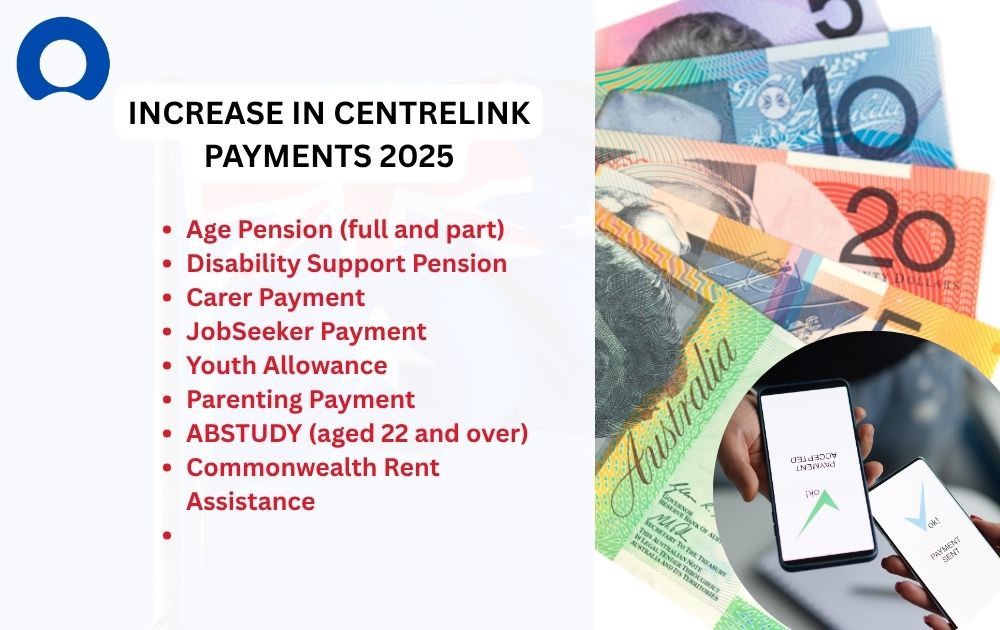For millions of Australians relying on government support, the October 2025 Centrelink payment increase brings welcome financial relief amid rising living costs. From 14 October 2025, new rates officially take effect, with Age Pension payments rising by up to $40.30 per fortnight for singles and $58.50 for couples combined.
This adjustment boosts the single Age Pension rate to $1,178.70 per fortnight, while couples will now receive $888.50 each. The increase reflects inflation adjustments aimed at safeguarding financial stability for seniors, carers, and other low-income Australians.
This latest Centrelink indexation ensures that older Australians and eligible beneficiaries can better manage everyday essentials from groceries to energy bills during challenging economic times.

Table of Contents
What Kind of Centrelink Payments Increased?
According to the Department of Social Services and major media outlets, as of 20 September 2025, the following Centrelink payments have been updated via indexation or adjustment:
- Age Pension (both full and part)
- Carer Payment
- Disability Support Pension
- Job Seeker Payment (and related allowances)
- Youth Allowance
- Parenting Payment (for both single and partnered parents)
- ABSTUDY (for recipients aged 22 and over)
- Commonwealth Rent Assistance (for eligible recipients)
In addition, new deeming rates (used in income tests on financial assets) have come into effect, which may alter net benefit amounts particularly for part-pensioners.
It’s important to note that not all benefits are indexed simultaneously; each program follows its own schedule and formula for adjustments.
How much are the increases?
Below are the key figures comparing “old rate” to “new rate” (effective 20 September 2025), along with the dollar increase and a rough percentage increase. These apply to maximum (full) rates for eligible recipients; lower or part rates may increase by smaller amounts.
Table 1: Key Payment Increases (Full Rates as of October 2025)
| Payment Type | Previous Rate (Fortnightly) | New Rate (Fortnightly) | Increase (Per Fortnight) | Approx. % Increase |
|---|---|---|---|---|
| Age Pension (Single) | $1,149.00 | $1,178.70 | +$29.70 | 2.58% |
| Age Pension (Each, Couple) | $813.90 | $888.50 | +$22.40 | 2.75% |
| Job Seeker (Single, over 22, no children) | $781.10 | $793.60 | +$12.50 | 1.60% |
| JobSeeker (Partnered, each) | $715.10 | $726.50 | +$11.40 | 1.59% |
| Parenting Payment (Single Parent) | $1,023.50 | $1,039.70 | +$16.20 | 1.58% |
| Parenting Payment (Partnered Parent) | $723.00 | $734.40 | +$11.40 | 1.58% |
| Rent Assistance (Single) | $212.00 | $215.40 | +$3.40 | 1.60% |
| Rent Assistance (Couple) | $199.80 | $203.00 | +$3.20 | 1.60% |
Notes:
- The above rates represent the full fortnightly payment amounts following the 20 September 2025 indexation.
- Increases were applied automatically for eligible recipients, reflecting inflation and cost-of-living adjustments under the biannual indexation system.
- Actual payment amounts may vary depending on income, assets, and personal circumstances.
Table 2: Selected Changes in Income and Asset Test Thresholds (as of October 2025)
| Threshold Type | Previous Value | New Value | Increase | Notes |
|---|---|---|---|---|
| Pension Disqualifying Income Limit (Single, Resident) | $2,516.00 | $2,575.40 | +$59.40 | Determines eligibility for full pension based on income. |
| Pension Disqualifying Income Limit (Couple Combined, Resident) | $3,844.40 | $3,934.00 | +$89.60 | Impacts combined income threshold for couples. |
| Asset Limit (Single, Homeowner) | $704,500 | $714,500 | +$10,000 | Maximum asset value before pension reduction begins. |
| Asset Limit (Couple, Both Homeowners) | $1,059,000 | $1,074,000 | +$15,000 | Combined asset limit for homeowner couples. |
| Deeming Lower Rate (on Financial Assets) | 0.25% | 0.75% | +0.50 pp | Used to calculate income from savings and investments. |
| Deeming Upper Rate | 2.25% | 2.75% | +0.50 pp | Applies to higher-value financial assets. |
Notes:
- These updates reflect indexation and deeming adjustments effective from 20 September 2025, aligning with broader cost-of-living revisions.
- The changes may impact part rate pensioners, as higher deeming rates can reduce calculated income from financial assets, partially offsetting increases in payment rates.
- Income and asset thresholds are reviewed regularly to maintain fairness and sustainability in the social security system.
Table 3: Deeming Rates and Their Impact on Pension Calculations (October 2025)
| Category | Deeming Rate | Applicable Financial Assets | Impact on Payments |
|---|---|---|---|
| Lower Deeming Rate | 0.75% | Applies to the first $60,400 of financial assets (singles) or the first $100,200 (couples combined). | Used to estimate income earned from low-value savings or investments. |
| Upper Deeming Rate | 2.75% | Applies to any financial assets above the lower threshold limits. | Increases the “assumed income” from assets, potentially reducing part-rate pensions. |
| Purpose of Deeming | — | Applies to term deposits, shares, managed funds, and bank accounts. | Ensures fairness and consistency in assessing income from investments. |
| Policy Note | — | Deeming rates were increased by 0.50 percentage points in September 2025. | Reflects stronger investment returns and economic adjustments. |
Summary: What These Changes Mean for Recipients
The increase in Centrelink payments for October 2025 provides meaningful relief for pensioners, carers, and job seekers, helping offset Australia’s ongoing cost-of-living pressures. However, the simultaneous rise in deeming rates and updated income and asset thresholds mean that some part-rate pensioners may not experience the full benefit of these payment increases.
Overall, the adjustments aim to balance support for vulnerable Australians with sustainable program management. While most recipients will see higher deposits in their bank accounts, those with larger savings or investments should review their situation, as higher deeming rates can slightly reduce entitlements. Seeking professional financial advice or reviewing Centrelink’s online calculator is recommended to understand individual impacts.

Why Does Centrelink Adjust Payments?
Centrelink payments are indexed twice each year, typically in March and September, to ensure that the value of government support keeps pace with Australia’s changing economic conditions. The goal of indexation is to maintain the real purchasing power of benefits, preventing inflation from eroding recipients’ financial stability.
The rate of increase is determined using the highest result among three key economic indicators:
- Consumer Price Index (CPI) Reflects general inflation and changes in the cost of goods and services.
- Male Total Average Weekly Earnings (MTAWE) Tracks growth in average wages across the country.
- Pensioner and Beneficiary Living Cost Index (PBLCI) Measures changes in the living costs specifically faced by pensioners and benefit recipients.
This “highest of the three” approach ensures that payments rise in line with the most relevant measure of economic pressure, helping Australians on fixed or low incomes better manage everyday expenses.
Adjusting Thresholds and Deeming Rates
Alongside regular indexation of payment rates, Centrelink also adjusts income and asset thresholds to ensure fairness and prevent what’s known as “bracket creep.” When base payment amounts rise but thresholds remain unchanged, some recipients could lose eligibility for part or full benefits simply because their income or assets move into a higher bracket. To avoid this, the Department of Social Services increases these limits in tandem with each indexation cycle, maintaining balance between payment growth and access criteria.
In addition to threshold adjustments, the government periodically reviews deeming rates the assumed rate of return used to calculate income from financial assets such as savings, term deposits, or investments. These rates are updated to reflect changes in interest rates and broader market conditions, ensuring that recipients with modest savings are treated fairly.
As part of the September 2025 updates, the lower deeming rate rose from 0.25% to 0.75%, and the upper deeming rate increased from 2.25% to 2.75%. While these changes align with improved investment returns, they can also reduce payments for some part-pensioners, depending on the value of their financial assets.

What’s the Impact on Recipients?
Who Benefits Most
Recipients on full pensions or full payments benefit the most in direct dollar terms, since their entire entitlement increases by the indexed amount. For instance, a single Age Pension recipient now receives an extra $29.70 per fortnight, reflecting the full rate adjustment.
Additionally, individuals who were previously close to the income or asset thresholds may now regain or improve eligibility, as these limits have also risen in line with the new rates. This helps prevent loss of access due to inflation or minor increases in income.
Potential Offsets
However, not all recipients experience the same advantage. Those on part-rate pensions or with higher levels of savings and investments may see smaller net gains due to increased deeming rates. Because Centrelink assumes higher returns on financial assets, the income test may reduce part of their payment. In some cases, the overall benefit may be modest—or even negligible—once the new deeming rates are applied.
Real Value and Adequacy
While the increase in Centrelink payments offers necessary relief, many community advocates argue that these adjustments still fall short of addressing the real cost-of-living pressures faced by low-income Australians. Pensioners and welfare recipients often spend a larger share of their income on essentials such as energy, healthcare, and housing, where prices have risen faster than general inflation.
Critics note that:
- The Consumer Price Index (CPI) does not fully capture pensioner-specific expenses.
- Periodic adjustments often fail to fully restore lost purchasing power over time.
- Current payment levels remain below key poverty benchmarks, such as the Henderson Poverty Line.
Despite these concerns, the government maintains that biannual indexation remains a vital mechanism to protect welfare recipients from inflation, ensuring that payments retain their core value as living costs evolve.
What You (as a Recipient) Need to Know and Do
1. No Need to Apply
The new payment rates are automatically applied to all eligible recipients. If you currently receive a qualifying Centrelink payment, you’ll see the increase reflected in your account once the updated rates take effect.
2. Check Your Bank Credits
Your first increased payment should appear in your bank account on or shortly after 20 September 2025, depending on your scheduled payment date. Keep an eye on your next fortnightly or weekly payment to confirm the updated amount has been processed.
3. Reassess Your Eligibility if Circumstances Change
If your income, assets, or living arrangements have changed recently, it’s important to review your eligibility. Because income and asset thresholds have been adjusted, your updated circumstances might now qualify you for a higher rate or, in some cases, reduce your entitlement. You can verify your current status through myGov or directly via Services Australia.
4. Be Aware of Deeming Rate Effects
If you hold financial assets such as savings, shares, or managed funds, remember that the new deeming rates may alter how your investment income is assessed. A higher deeming rate means more of your assets may be counted as “income,” potentially affecting your payment level. It’s wise to review your financial details and ensure they are up to date in your Centrelink record.
5. Keep Documentation and Review Notices
Services Australia may send you updated statements or notifications outlining your new payment rate. Ensure your contact details especially your postal and email addresses are current so you don’t miss any important correspondence. Review all notices carefully to understand how the new rates apply to your situation.
Broader Context and Commentary
Inflation and Cost-of-Living Pressures
Australia has faced persistent inflation in recent years, particularly in essential areas such as food, housing, energy, and healthcare. These cost of living pressures have placed considerable strain on fixed income households. Regular indexation of Centrelink payments is designed to protect recipients from a decline in purchasing power, helping maintain a basic standard of living as prices rise.
Political and Public Discourse
While the rate increases are broadly welcomed, many experts and welfare advocates argue that indexation alone is insufficient. They note that linking welfare adjustments purely to inflation does not address deeper structural challenges such as stagnant wage growth, rising housing costs, and widening income inequality.
There is also debate over the deeming rate system, with some recipients and policy observers suggesting it may unfairly penalize savers by assuming investment returns that don’t always match real-world performance.
Long-Term Sustainability
From a policy standpoint, the government faces a balancing act between fiscal responsibility and social equity. Regular indexation provides a stable, predictable mechanism to preserve the real value of welfare payments. However, more substantial increases—those exceeding inflation—would require larger budget allocations and long-term political commitment.
As Australia’s population ages, the number of people receiving pensions and benefits is expected to grow, adding further pressure to the national welfare budget. Ensuring the sustainability and adequacy of these payments will remain a key issue in Australia’s economic and social policy landscape.
Limitations, Caveats & Exceptions
While the September 2025 Centrelink payment increases are positive overall, several important nuances should be noted:
- Maximum rates only: The announced figures represent maximum payment amounts. Recipients whose income or assets exceed certain thresholds will continue to receive part rates, meaning their actual increase may be smaller.
- Non-indexed supplements: Some additional payments such as the Energy Supplement are not indexed, so their dollar value remains unchanged even after the latest adjustment.
- Special provisions: Certain transitional or special pension categories follow different indexation rules or schedules, which may result in variations in the applied increase.
- Residency conditions: Recipients who live overseas or spend extended periods outside Australia may experience changes or reductions in their entitlements, depending on their duration of absence and residency status.
- Deeming rate effects: Updated deeming rates can have unintended impacts on part rate pensioners or individuals with substantial financial assets. In some cases, higher assumed returns on investments may reduce their overall payment despite the headline increase.
Summary
The September 2025 indexation of Centrelink payments provides a modest yet meaningful boost to millions of welfare and pension recipients across Australia. Those on full payments such as Age Pensioners and Job Seeker recipients will notice clear gains, with increases of around $29.70 per fortnight for single Age Pensioners and $12.50 for single Job Seeker recipients.
However, for recipients on part rates or with significant financial assets, the overall benefit may be moderated by updated means testing and deeming rates, which can offset part of the gain.
While these increases help preserve the real purchasing power of social benefits amid ongoing inflation, many social advocates continue to argue that they do not yet deliver a truly adequate or sustainable living income especially for individuals and families relying solely on welfare support.
Overall, the September 2025 changes reflect the government’s continuing effort to balance cost-of-living relief with fiscal responsibility, ensuring that the social security system remains responsive to both economic pressures and community needs.
Frequently Asked Questions About the Increase in Centrelink Payments (October 2025)
1. What is the latest increase in Centrelink payments for October 2025?
As of 20 September 2025, Centrelink payments, including the Age Pension, JobSeeker, Youth Allowance, and Disability Support Pension, have all increased following the government’s biannual indexation. For example, single Age Pensioners receive an extra $29.70 per fortnight, while JobSeeker singles get $12.50 more.
2. Why did Centrelink payments increase in 2025?
Centrelink payments are indexed twice a year in March and September to help maintain their real value against inflation. The latest increase reflects rising living costs, wages, and CPI data, ensuring that payments keep up with everyday expenses.

3. Which Centrelink payments were affected by the increase?
The October 2025 increase applies to several payments, including:
- Age Pension (full and part)
- Disability Support Pension
- Carer Payment
- JobSeeker Payment
- Youth Allowance
- Parenting Payment
- ABSTUDY (aged 22 and over)
- Commonwealth Rent Assistance
4. How much did the Age Pension increase?
For single recipients, the Age Pension increased by $29.70 per fortnight, and for couples combined, the rise is $44.80 per fortnight. The new rates aim to ease cost-of-living pressures for retirees.
5. How do deeming rate changes affect the increase in Centrelink payments?
Deeming rates, used to estimate income from investments, also rose in 2025. The lower deeming rate increased from 0.25% to 0.75%, and the upper rate from 2.25% to 2.75%. This may slightly reduce the net benefit for part-pensioners or people with higher savings.
6. Do I need to apply to receive the new Centrelink rates?
No. The increase in Centrelink payments is automatic. Eligible recipients will see the new rates applied to their accounts from 20 September 2025 onward no additional application or action is required.
7. Will my income or assets affect how much I receive after the increase?
Yes. Your payment amount still depends on income and asset tests. While both thresholds were raised in 2025, higher income or substantial assets may still reduce your total entitlement.
8. Does the increase in Centrelink payments apply to everyone in Australia?
The increase applies to all eligible recipients residing in Australia. However, individuals living overseas or spending extended periods outside the country may receive adjusted or reduced rates depending on their residency status.
9. How often does Centrelink increase its payments?
Centrelink payments are generally reviewed and adjusted twice a year in March and September to reflect inflation and wage growth. This ensures the real value of welfare support is maintained over time.
10. Where can I check my updated Centrelink payment amount?
You can view your updated payment amount by logging into your myGov account and selecting Services Australia. Alternatively, you’ll find the new payment details in your next Centrelink statement or bank deposit after the change date.
Disclaimer
assisinfoau.com provides general information and news updates regarding Centrelink payments, welfare rates, and related government assistance programs.
We are not affiliated with, endorsed by, or officially connected to Services Australia, Centrelink, or any other government department.
All details are based on publicly available information from official sources and reputable media reports. Readers are encouraged to verify current payment rates and eligibility through the official Services Australia website or by contacting Centrelink directly.
